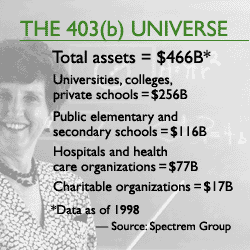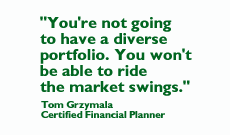NEW YORK (CNNfn) - You're not all about money. You're about doing meaningful work and devoting yourself to something higher than the almighty profit. So you work for a dot.org or call the classroom home. And while your workload mimics a tsunami, the rewards are often without measure.
Except when it comes to your retirement savings. For that, you might want to pull out the yardstick.
If you work for a nonprofit, you may never make as much as your for-profit peers - or, in some cases, even their 20-something underlings. So your dollars need to go further to provide you with a comfortable living when you retire.
Which is why you should take advantage of a tax-deferred savings plan known as a 403(b) if your employer offers it. But also consider other investment options as well, because 403(b)s don't always provide the kind of investment choices that let your nest egg beat the Street.
Like a 401(k), but not
On the surface, a 403(b), also known as a tax-sheltered annuity or TSA, may seem a lot like a 401(k). You contribute to it using pre-tax earnings, which grow tax-deferred until you withdraw from the fund at retirement. Your employer may offer matching contributions. And you may contribute up to $10,500 per year or a certain percentage of your salary - up to 20 percent in the case of 403(b)s -- whichever is less.

Rollover options are also close cousins. If you're leaving a job, you may roll over your money into an IRA or the 403(b) plan at your new job. (Keep in mind, if you join a business, you may not move 403(b) money into a 401(k), however.) And as with a corporate-sponsored plan, you can't contribute to a 403(b) if you leave it with your old employer.
But the similarities end there.
'More of a service than a plan'
The first thing to keep in mind is that nonprofits offering a 403(b) are providing "more of a service than a plan," said PMG Securities Managing Director Walter McBay.
That's because the employer acts as a conduit, not a fiduciary the way a company with a 401(k) does. The nonprofit does not assume any risk with the plan - that's left to an outside plan provider - or the administrative costs, which are paid by the employees who participate.
And generally speaking, there's less effort to educate or encourage employees to participate in the plan, said Chris Cumming of Diversified Investments Advisors, which specializes in retirement issues. "Access and emphasis are less," he said.
Greater flexibility a plus
Another key difference is the flexibility 403(b) participants enjoy when it comes to playing "catch-up" in their savings contributions.
You've heard it countless times - max out your contributions. Well, sometimes life's expenses get out of hand and you just can't.
With a 401(k), there are no "do-overs." If you're pinched one year, you can't compensate by putting in more than the allowable contribution the next. But with a 403(b), sometimes you can.
 To qualify, you have to be employed at the same place for 15 years and must not have "maxed out" your plan in prior years, McBay said. If this is the case, then you are entitled to contribute up to $13,500 for each year going forward. The "catch-up" provision is intended to help those nearing retirement that need to bolster their savings. To qualify, you have to be employed at the same place for 15 years and must not have "maxed out" your plan in prior years, McBay said. If this is the case, then you are entitled to contribute up to $13,500 for each year going forward. The "catch-up" provision is intended to help those nearing retirement that need to bolster their savings.
There's also greater flexibility when it comes to rollovers. If you're dissatisfied with the performance of your 403(b) but are not ready to leave your job, you may roll over some of your money into another custodial 403(b) account from a provider of your choosing, said Daniel Lamaute, a principal of Lamaute Capital.
So, if your plan only offers Fidelity funds but you prefer a Janus fund, you're free to switch, providing you transfer only that money which you have contributed. You may not roll over matching contributions from your employer. And when it comes to future contributions, your payroll deductions must first go to the 403(b) plan at your job.
And when it comes to early retirement, 403(b) participants may have an edge. Generally speaking, you will incur penalties for withdrawals made before age 59-1/2 under both a 401(k) and a 403(b). But if you are retiring anytime after turning 55, you may make withdrawals from your 403(b) without penalty, said certified financial planner Bruce Buttle.
Bias toward annuities, large caps
The savings flexibility afforded, however, does not extend to investment choice.
Up until now, the insurance industry has been the dominant provider in the 403(b) market, and as a result, annuities are the most widely sold products. In terms of asset distribution in 1997, 52 percent of 403(b) money went into fixed annuities, 33 percent in variable annuities, and 15 percent into mutual funds, according to the Spectrem Group, a consulting firm.

"Historically, people have looked at those who work in non-profits as conservative," McBay said. "People have sold tax savings instead of return."
An annuity - which pays you a fixed amount every month in your retirement and often a death benefit, in which your principal is recovered after you die - offers an appealing kind of security to some. But participants pay for that security with higher fees and, often, a lower overall return compared with a mutual fund.
Now, "people want the potential of better rewards," McBay said, especially in light of the bull market.
Diversification is up to you
What access to stocks 403(b) participants do have in their choice of mutual funds and variable annuities is often limited to large-caps "because they're safe," said certified financial planner Tom Grzymala.
That means you shouldn't necessarily rely solely on your 403(b) for balance in asset allocation.
"You're not going to have a diverse portfolio. You won't be able to ride the market swings," Grzymala said, citing the strong performance of small caps in recent months.
You can diversify by starting an IRA in addition to your 403(b), or by investing after-tax dollars in a small or mid-cap equity fund.
If you have no access to mutual funds or variable annuities in your plan, be sure to allocate some money to stocks or stock funds, Buttle suggested.
Take control of your options
Making your 403(b) work to your advantage means taking charge. Your job may not be about money, but many of your retirement needs are.
Participants need to educate themselves about their options, McBay said. And they need to speak up.
You can lobby your employer for greater choice in your 403(b), or ask that the organization start a matching program, which is often a good employee-retention tool in addition to any pension plan offered.
But most important, when it comes to your retirement investments, "you have to comparison-shop," McBay said. 
|

